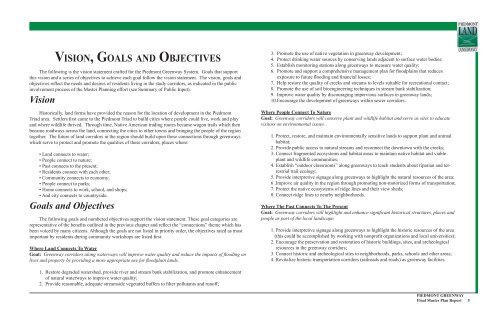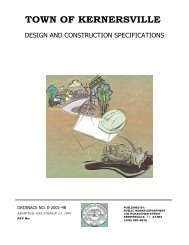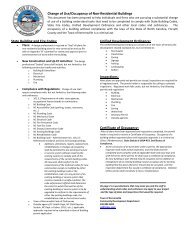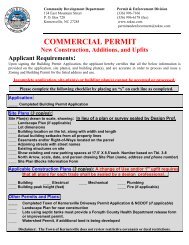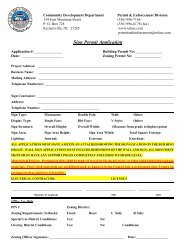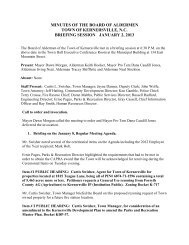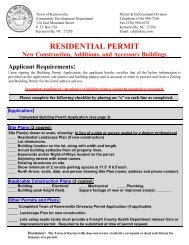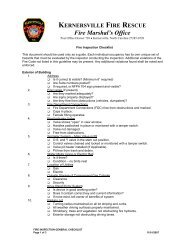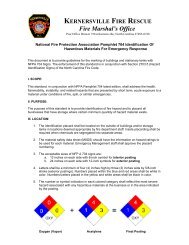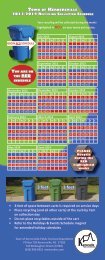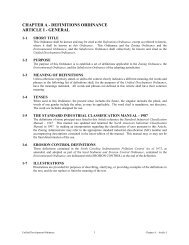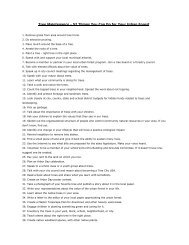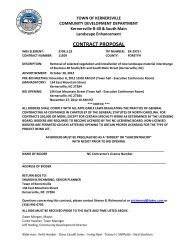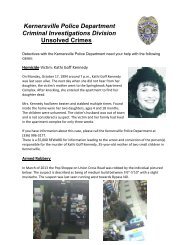Piedmont Greenway Master Plan - Town of Kernersville
Piedmont Greenway Master Plan - Town of Kernersville
Piedmont Greenway Master Plan - Town of Kernersville
- No tags were found...
You also want an ePaper? Increase the reach of your titles
YUMPU automatically turns print PDFs into web optimized ePapers that Google loves.
VISION, GOALS AND OBJECTIVES<br />
The following is the vision statement crafted for the <strong>Piedmont</strong> <strong>Greenway</strong> System. Goals that support<br />
this vision and a series <strong>of</strong> objectives to achieve each goal follow the vision statement. The vision, goals and<br />
objectives reflect the needs and desires <strong>of</strong> residents living in the study corridors, as indicated in the public<br />
involvement process <strong>of</strong> the <strong>Master</strong> <strong>Plan</strong>ning effort (see Summary <strong>of</strong> Public Input).<br />
Vision<br />
Historically, land forms have provided the reason for the location <strong>of</strong> development in the <strong>Piedmont</strong><br />
Triad area. Settlers first came to the <strong>Piedmont</strong> Triad to build cities where people could live, work and play<br />
and where wildlife thrived. Through time, Native American trading routes became wagon trails which then<br />
became roadways across the land, connecting the cities to other towns and bringing the people <strong>of</strong> the region<br />
together. The future <strong>of</strong> land corridors in the region should build upon these connections through greenways<br />
which serve to protect and promote the qualities <strong>of</strong> these corridors, places where:<br />
• Land connects to water;<br />
• People connect to nature;<br />
• Past connects to the present;<br />
• Residents connect with each other;<br />
• Community connects to economy;<br />
• People connect to parks;<br />
• Home connects to work, school, and shops;<br />
• And city connects to countryside.<br />
Goals and Objectives<br />
The following goals and numbered objectives support the vision statement. These goal categories are<br />
representative <strong>of</strong> the benefits outlined in the previous chapter and reflect the “connections” theme which has<br />
been voiced by many citizens. Although the goals are not listed in priority order, the objectives rated as most<br />
important by residents during community workshops are listed first.<br />
Where Land Connects To Water<br />
Goal: <strong>Greenway</strong> corridors along waterways will improve water quality and reduce the impacts <strong>of</strong> flooding on<br />
lives and property by providing a more appropriate use for floodplain lands.<br />
3. Promote the use <strong>of</strong> native vegetation in greenway development;<br />
4. Protect drinking water sources by conserving lands adjacent to surface water bodies;<br />
5. Establish monitoring stations along greenways to measure water quality;<br />
6. Promote and support a comprehensive management plan for floodplains that reduces<br />
exposure to future flooding and financial losses;<br />
7. Help restore the quality <strong>of</strong> creeks and streams to levels suitable for recreational contact;<br />
8. Promote the use <strong>of</strong> soil bioengineering techniques in stream bank stabilization;<br />
9. Improve water quality by discouraging impervious surfaces in greenway lands;<br />
10.Encourage the development <strong>of</strong> greenways within sewer corridors.<br />
Where People Connect To Nature<br />
Goal: <strong>Greenway</strong> corridors will conserve plant and wildlife habitat and serve as sites to educate<br />
visitors on environmental issues.<br />
1. Protect, restore, and maintain environmentally sensitive lands to support plant and animal<br />
habitat;<br />
2. Provide public access to natural streams and reconnect the downtown with the creeks;<br />
3. Connect fragmented ecosystems and habitat areas to maintain native habitat and viable<br />
plant and wildlife communities;<br />
4. Establish “outdoor classrooms” along greenways to teach students about riparian and terrestrial<br />
trail ecology;<br />
5. Provide interpretive signage along greenways to highlight the natural resources <strong>of</strong> the area;<br />
6 .Improve air quality in the region through promoting non-motorized forms <strong>of</strong> transportation;<br />
7. Protect the native ecosystems <strong>of</strong> ridge lines and their view sheds;<br />
8. Connect ridge lines to nearby neighborhoods.<br />
Where The Past Connects To The Present<br />
Goal: <strong>Greenway</strong> corridors will highlight and enhance significant historical structures, places and<br />
people as part <strong>of</strong> the local landscape.<br />
1. Provide interpretive signage along greenways to highlight the historic resources <strong>of</strong> the area<br />
(this could be accomplished by working with nonpr<strong>of</strong>it organizations and local universities);<br />
2. Encourage the preservation and restoration <strong>of</strong> historic buildings, sites, and archeological<br />
resources in the greenway corridors;<br />
3. Connect historic and archeological sites to neighborhoods, parks, schools and other areas;<br />
4. Revitalize historic transportation corridors (railroads and roads) as greenway facilities.<br />
1. Restore degraded watershed, provide river and stream bank stabilization, and promote enhancement<br />
<strong>of</strong> natural waterways to improve water quality;<br />
2. Provide reasonable, adequate streamside vegetated buffers to filter pollutants and run<strong>of</strong>f;<br />
PIEDMONT GREENWAY<br />
Final <strong>Master</strong> <strong>Plan</strong> Report 5


